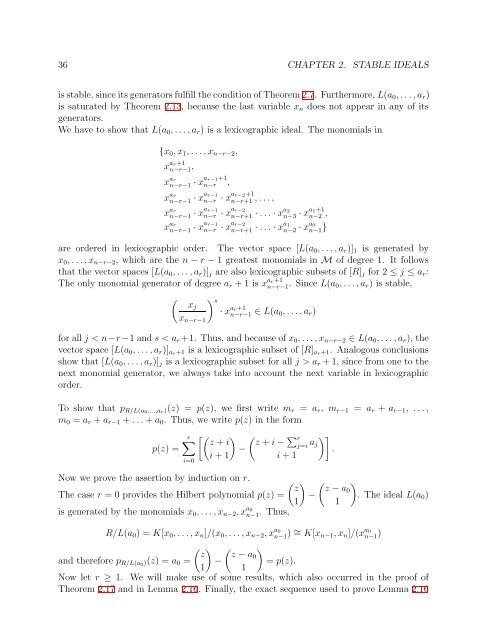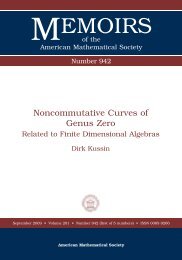University of Paderborn Department of Mathematics Diploma Thesis ...
University of Paderborn Department of Mathematics Diploma Thesis ...
University of Paderborn Department of Mathematics Diploma Thesis ...
You also want an ePaper? Increase the reach of your titles
YUMPU automatically turns print PDFs into web optimized ePapers that Google loves.
36 CHAPTER 2. STABLE IDEALSis stable, since its generators fulfill the condition <strong>of</strong> Theorem 2.7. Furthermore, L(a 0 , . . . , a r )is saturated by Theorem 2.13, because the last variable x n does not appear in any <strong>of</strong> itsgenerators.We have to show that L(a 0 , . . . , a r ) is a lexicographic ideal. The monomials in{x 0 , x 1 , . . . , x n−r−2 ,x ar+1n−r−1,x arn−r−1 · x a r−1+1n−r ,x arn−r−1 · x a r−1n−r · x a r−2+1n−r+1 , . . . ,x arn−r−1 · x a r−1n−r · x a r−2n−r+1 · . . . · x a 2n−3 · x a 1+1n−2 ,x arn−r−1 · x a r−1n−r · x a r−2n−r+1 · . . . · x a 1n−2 · x a 0n−1}are ordered in lexicographic order. The vector space [L(a 0 , . . . , a r )] 1 is generated byx 0 , . . . , x n−r−2 , which are the n − r − 1 greatest monomials in M <strong>of</strong> degree 1. It followsthat the vector spaces [L(a 0 , . . . , a r )] j are also lexicographic subsets <strong>of</strong> [R] j for 2 ≤ j ≤ a r :The only monomial generator <strong>of</strong> degree a r + 1 is x ar+1n−r−1. Since L(a 0 , . . . , a r ) is stable,( ) s xj· x ar+1n−r−1 ∈ L(a 0 , . . . , a r )x n−r−1for all j < n−r−1 and s < a r +1. Thus, and because <strong>of</strong> x 0 , . . . , x n−r−2 ∈ L(a 0 , . . . , a r ), thevector space [L(a 0 , . . . , a r )] ar+1 is a lexicographic subset <strong>of</strong> [R] ar+1. Analogous conclusionsshow that [L(a 0 , . . . , a r )] j is a lexicographic subset for all j > a r + 1, since from one to thenext monomial generator, we always take into account the next variable in lexicographicorder.To show that p R/L(a0 ,...,a r)(z) = p(z), we first write m r = a r , m r−1 = a r + a r−1 , . . . ,m 0 = a r + a r−1 + . . . + a 0 . Thus, we write p(z) in the formp(z) =r∑i=0[( ) z + i−i + 1( z + i −∑ rj=i a ji + 1Now we prove the assertion by induction on r. ( ( )z z − a0The case r = 0 provides the Hilbert polynomial p(z) = − . The ideal L(a 0 )1)1is generated by the monomials x 0 , . . . , x n−2 , x a 0n−1. Thus,R/L(a 0 ) = K[x 0 , . . . , x n ]/(x 0 , . . . , x n−2 , x a 0n−1) ∼ = K[x n−1 , x n ]/(x a 0n−1)( ( )z z − a0and therefore p R/L(a0 )(z) = a 0 = − = p(z).1)1Now let r ≥ 1. We will make use <strong>of</strong> some results, which also occurred in the pro<strong>of</strong> <strong>of</strong>Theorem 2.17 and in Lemma 2.16. Finally, the exact sequence used to prove Lemma 2.16)].
















